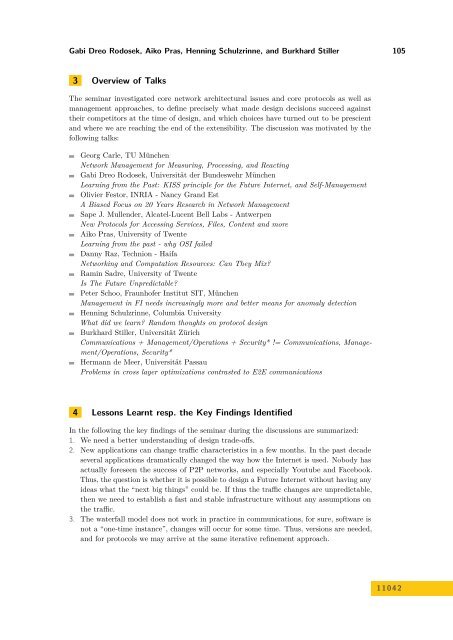Volume 1, Issue 1, January 2011 - DROPS - Schloss Dagstuhl
Volume 1, Issue 1, January 2011 - DROPS - Schloss Dagstuhl
Volume 1, Issue 1, January 2011 - DROPS - Schloss Dagstuhl
Create successful ePaper yourself
Turn your PDF publications into a flip-book with our unique Google optimized e-Paper software.
Gabi Dreo Rodosek, Aiko Pras, Henning Schulzrinne, and Burkhard Stiller 105<br />
3 Overview of Talks<br />
The seminar investigated core network architectural issues and core protocols as well as<br />
management approaches, to define precisely what made design decisions succeed against<br />
their competitors at the time of design, and which choices have turned out to be prescient<br />
and where we are reaching the end of the extensibility. The discussion was motivated by the<br />
following talks:<br />
Georg Carle, TU München<br />
Network Management for Measuring, Processing, and Reacting<br />
Gabi Dreo Rodosek, Universität der Bundeswehr München<br />
Learning from the Past: KISS principle for the Future Internet, and Self-Management<br />
Olivier Festor, INRIA - Nancy Grand Est<br />
A Biased Focus on 20 Years Research in Network Management<br />
Sape J. Mullender, Alcatel-Lucent Bell Labs - Antwerpen<br />
New Protocols for Accessing Services, Files, Content and more<br />
Aiko Pras, University of Twente<br />
Learning from the past - why OSI failed<br />
Danny Raz, Technion - Haifa<br />
Networking and Computation Resources: Can They Mix?<br />
Ramin Sadre, University of Twente<br />
Is The Future Unpredictable?<br />
Peter Schoo, Fraunhofer Institut SIT, München<br />
Management in FI needs increasingly more and better means for anomaly detection<br />
Henning Schulzrinne, Columbia University<br />
What did we learn? Random thoughts on protocol design<br />
Burkhard Stiller, Universität Zürich<br />
Communications + Management/Operations + Security* != Communications, Management/Operations,<br />
Security*<br />
Hermann de Meer, Universität Passau<br />
Problems in cross layer optimizations contrasted to E2E communications<br />
4 Lessons Learnt resp. the Key Findings Identified<br />
In the following the key findings of the seminar during the discussions are summarized:<br />
1. We need a better understanding of design trade-offs.<br />
2. New applications can change traffic characteristics in a few months. In the past decade<br />
several applications dramatically changed the way how the Internet is used. Nobody has<br />
actually foreseen the success of P2P networks, and especially Youtube and Facebook.<br />
Thus, the question is whether it is possible to design a Future Internet without having any<br />
ideas what the “next big things” could be. If thus the traffic changes are unpredictable,<br />
then we need to establish a fast and stable infrastructure without any assumptions on<br />
the traffic.<br />
3. The waterfall model does not work in practice in communications, for sure, software is<br />
not a “one-time instance”, changes will occur for some time. Thus, versions are needed,<br />
and for protocols we may arrive at the same iterative refinement approach.<br />
1 1 0 4 2













